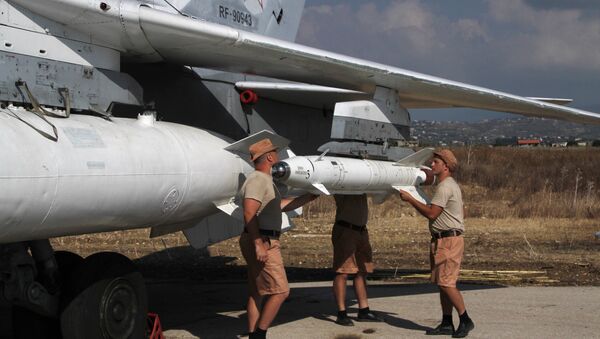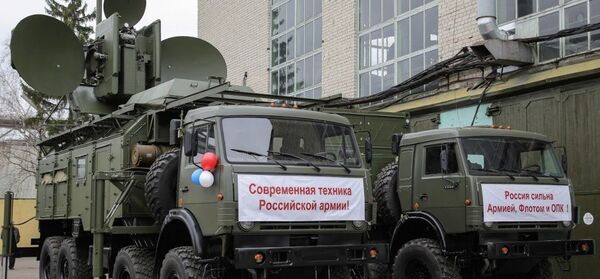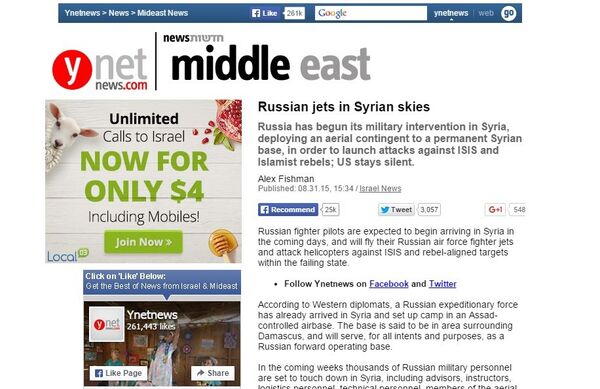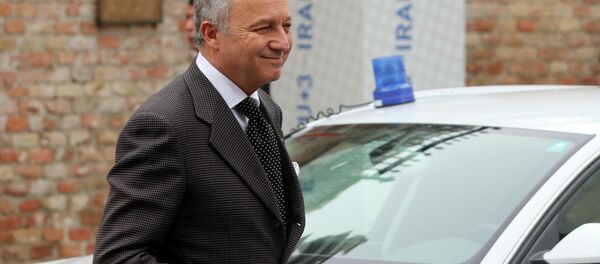On August 16, the Turkish web portal BGN News reported on the alleged deployment of six Russian supersonic MiG-31 interceptor aircraft outside the Syrian capital Damascus. The information was never independently confirmed, but some experts insist that the deployment did take place for reconnaissance purposes ahead of a major air operation. In this regard, it would be irrelevant to suggest that the planes were MiG-31s, experts added.
August 31 saw a report by the new website Ynetnews, which touched upon the forthcoming Russian military operation against the Islamic State in Syria. According to Ynetnews, Russia's air campaign was allegedly in agreement with Washington and Tel Aviv. At the time, an Israeli military source told the Russian news website Lenta.ru that Russia was increasing its presence in Syria, and that Russia's air operations were based there. A month later, it becomes clear that the situation back then was in line with the Ynetnews report, Lenta.ru said.
On September 2, an increasing number of Ynetnews reposts prompted the Russian President's spokesman Dmitry Peskov to urge against believing in rumors about the involvement of Russian aircraft in fighting the Islamic State. The statement, it must be mentioned, was fully in line with the situation at the time.
Four days later, it was reported that the Russian civilian ferry Alexander Tkachenko had been spotted in the Black Sea bays, loaded with motor vehicles and fuel tanks. On the same day, Russia launched large-scale combat readiness drills in the country's Central Military District, which lasted until September 12. The exercises were followed with the Center-2015 strategic war games, which wrapped up on September 20. Later on, the Russian newspaper Kommersant quoted some sources as claiming that the Russian aircraft were covertly delivered to Syria under the guise of these drills.
On September 9, American and British media cited sources in the Pentagon as saying that Russia planned to build a new air base in Syria, near the port of Latakia. The sources declined to elaborate. Later that day, the Russian Foreign Ministry said that Moscow has never made any secret of its military-technical cooperation with Damascus, including the supply of arms to Syria. The ministry pledged to consider the issue of Russia taking "additional measures in favor of increasing support for the fight against terrorism."
Satellite Image Analysis of Russia's Military Buildup in Syria https://t.co/0Er4r30UKM via @rightrelevance thanks @stratfor
— Leonardo Martins (@leophoto) 25 сентября 2015
On September 18, the Western media published an array of photos of the Syrian airfield Hmeimim, which showed four Russian fighter jets Su-30SM deployed there. It was reported that early the following month, aircraft were to be delivered to Latakia on board an Il-76 military transport jet via the airspace of Azerbaijan, Iran and Iraq.
On September 22, the US military published new pictures of the Hmeimim airfield, where twelve Russian Su-25SM attack aircraft and twelve Russian Su-24M front-line bombers were seen stationed. The US alleged that the deployment took place between September 21 and September 22. In addition, Washington claimed that earlier, the airfield saw the deployment of fifteen Russian Mi-8 multi-purpose helicopters and Mi-24 attack helicopters.
#Russian airbase in #Syria: RT checks out everyday life at Latakia airfield http://t.co/ONaAMnjm3d pic.twitter.com/xj6dMGZVgJ
— Victor Kuhnovets (@vicktop55) 3 октября 2015
On September 24, Russia announced its upcoming Navy drills in the eastern Mediterranean. The exercises were scheduled to start on September 30, a date that was to mark the beginning of Russia's air operation in Syria.
#Russia|n airbase in #Syria: RT checks out everyday life at #Latakia airfield http://t.co/PTnPCU1AcP https://t.co/xOCN74PaAF
— Nenad Jovanovic (@DracoDoclean) 3 октября 2015
September 28 saw the publication of photos of Russian Su-34 bombers flying over Hmeimim airfield, the Caspian Sea, and the territory of Iran and Iraq. On the same day, Russian President Vladimir Putin spoke at the UN General Assembly and later met with his US counterpart President Barack Obama on the sidelines of the gathering. Importantly, the go-ahead for Russia's operation was given following the conclusion of the highest-level meetings, including those between Russian Foreign Minister Sergei Lavrov and his US and German colleagues John Kerry and Frank-Walter Steinmeier, respectively.
On September 30, more than fifty Russian aircraft and helicopters commenced precision airstrikes on Islamic State targets in Syria at the request of Syrian President Bashar Assad. Earlier that day, the Russian upper house of parliament unanimously supported President Vladimir Putin's request to deploy Russian Aerospace Force units abroad.





